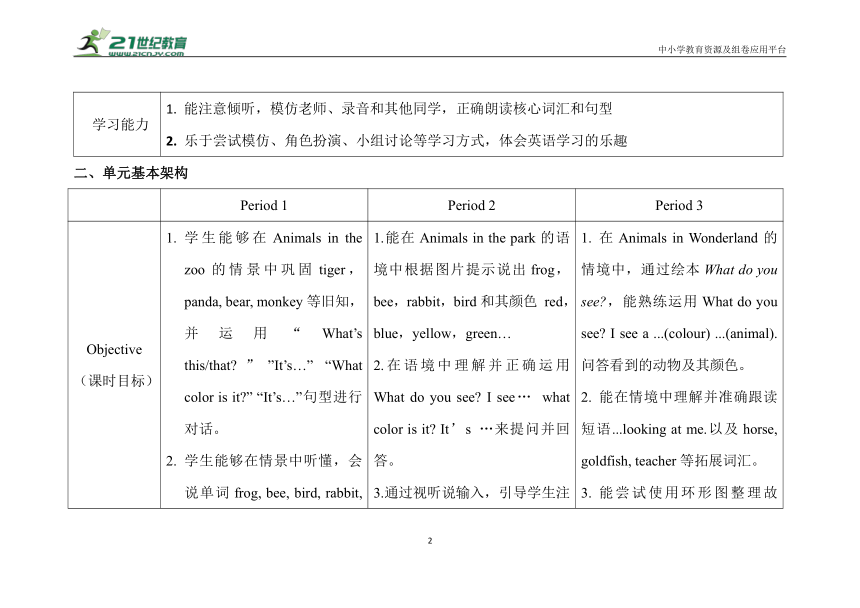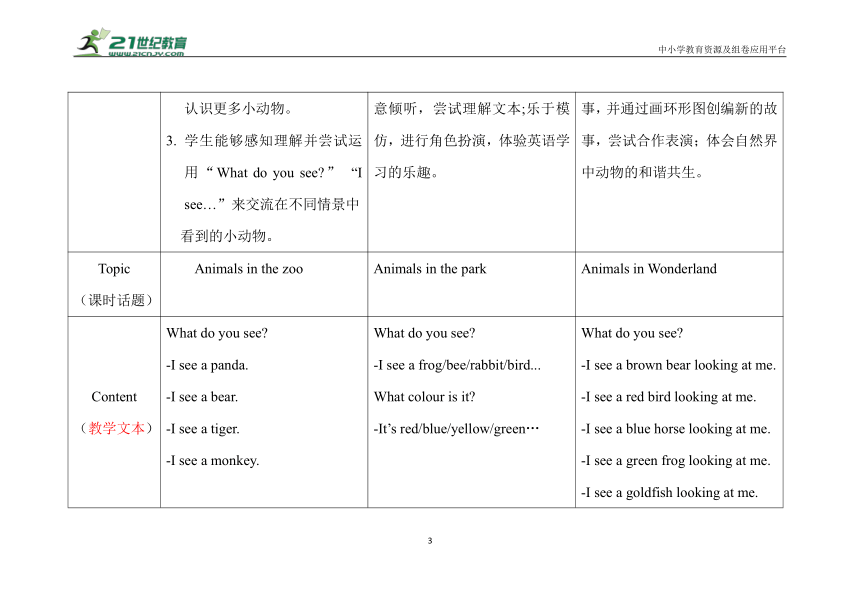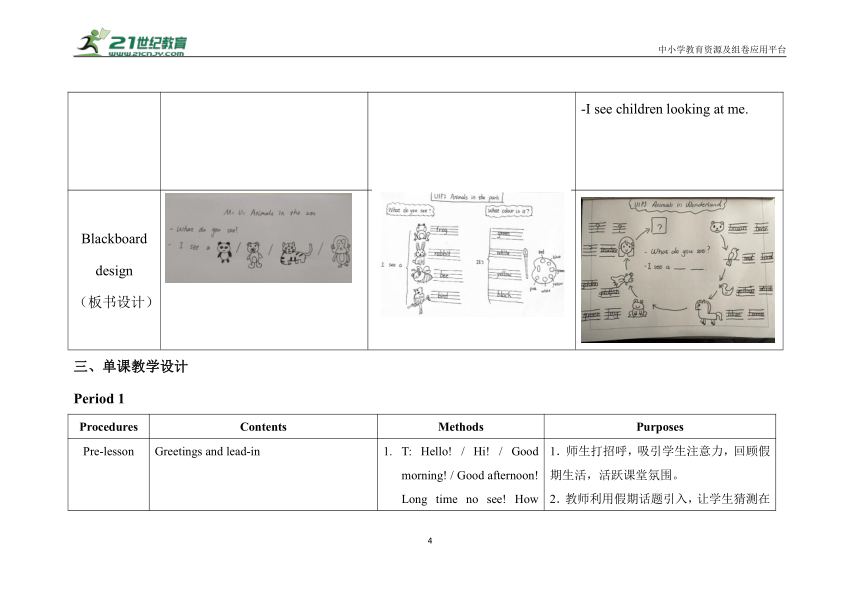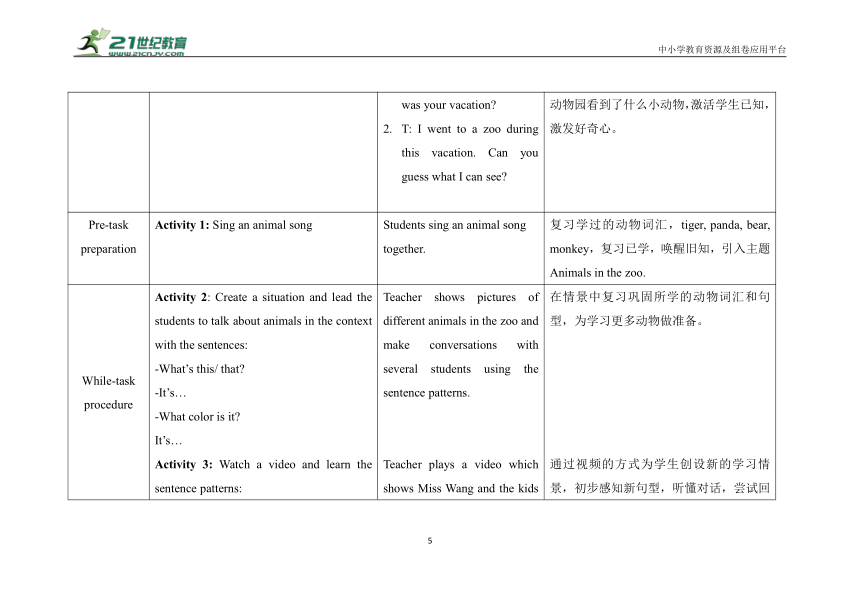Module 1 Unit 1 Look and see 单元整体教学设计
文档属性
| 名称 | Module 1 Unit 1 Look and see 单元整体教学设计 |

|
|
| 格式 | docx | ||
| 文件大小 | 452.9KB | ||
| 资源类型 | 试卷 | ||
| 版本资源 | 牛津深圳版 | ||
| 科目 | 英语 | ||
| 更新时间 | 2023-06-08 14:43:06 | ||
图片预览





文档简介
中小学教育资源及组卷应用平台
Teachers’ Unit-based Teaching design
学校: 备课组老师:
Title: _1_B Module _1_Unit _1 Look and see 日期:
一、单元教学目标 (参照2022版课标中的分级标准描述)
语用任务:能在适当的情境中运用What do you see I see .... What colour is it It’s ... 问答所看到的动物及其颜色,进行角色扮演、故事创编。
语言能力 能在情境中理解、准确运用frog, rabbit, bird, bee等新词、滚动运用bear, tiger等旧词、以及句型What do you see I see a ...问答所看到的动物及其颜色 能在看、听、说活动中,理解绘本故事What do you see ,并梳理出所看到的小动物及其颜色
文化意识 能通过图片、绘本、歌谣等,了解动物、热爱动物,体会自然界中各种动物的和谐共生
思维品质 能尝试使用环形图整理故事,并通过画环形图创编新的故事,尝试合作表演
学习能力 能注意倾听,模仿老师、录音和其他同学,正确朗读核心词汇和句型 乐于尝试模仿、角色扮演、小组讨论等学习方式,体会英语学习的乐趣
二、单元基本架构
Period 1 Period 2 Period 3
Objective (课时目标) 学生能够在Animals in the zoo的情景中巩固tiger,panda, bear, monkey等旧知,并运用“What’s this/that ””It’s…” “What color is it ” “It’s…”句型进行对话。 学生能够在情景中听懂,会说单词frog, bee, bird, rabbit, 认识更多小动物。 学生能够感知理解并尝试运用“What do you see ” “I see…”来交流在不同情景中 看到的小动物。 1.能在Animals in the park的语境中根据图片提示说出frog,bee,rabbit,bird和其颜色 red,blue,yellow,green… 2.在语境中理解并正确运用What do you see I see… what color is it It’s …来提问并回答。 3.通过视听说输入,引导学生注意倾听,尝试理解文本;乐于模仿,进行角色扮演,体验英语学习的乐趣。 在Animals in Wonderland的情境中,通过绘本What do you see ,能熟练运用What do you see I see a ...(colour) ...(animal).问答看到的动物及其颜色。 能在情境中理解并准确跟读短语...looking at me.以及horse, goldfish, teacher等拓展词汇。 能尝试使用环形图整理故事,并通过画环形图创编新的故事,尝试合作表演;体会自然界中动物的和谐共生。
Topic (课时话题) Animals in the zoo Animals in the park Animals in Wonderland
Content (教学文本) What do you see -I see a panda. -I see a bear. -I see a tiger. -I see a monkey. What do you see -I see a frog/bee/rabbit/bird... What colour is it -It’s red/blue/yellow/green… What do you see -I see a brown bear looking at me. -I see a red bird looking at me. -I see a blue horse looking at me. -I see a green frog looking at me. -I see a goldfish looking at me. -I see children looking at me.
Blackboard design (板书设计)
三、单课教学设计
Period 1
Procedures Contents Methods Purposes
Pre-lesson Greetings and lead-in T: Hello! / Hi! / Good morning! / Good afternoon! Long time no see! How was your vacation T: I went to a zoo during this vacation. Can you guess what I can see 1.师生打招呼,吸引学生注意力,回顾假期生活,活跃课堂氛围。 2.教师利用假期话题引入,让学生猜测在动物园看到了什么小动物,激活学生已知,激发好奇心。
Pre-task preparation Activity 1: Sing an animal song Students sing an animal song together. 复习学过的动物词汇,tiger, panda, bear, monkey,复习已学,唤醒旧知,引入主题Animals in the zoo.
While-task procedure Activity 2: Create a situation and lead the students to talk about animals in the context with the sentences: -What’s this/ that -It’s… -What color is it It’s… Activity 3: Watch a video and learn the sentence patterns: -What do you see -I see… Activity 4: Read the dialogue with different roles. Teacher shows pictures of different animals in the zoo and make conversations with several students using the sentence patterns. Teacher plays a video which shows Miss Wang and the kids are learning about animals in the classroom. Teacher asks students “What do you see ” with pictures. Students read the dialogue after the tape. Then teacher displays the text and students read the dialogue with different roles. For example, the boys are Miss Wang and they ask questions and the girls answer the questions. 在情景中复习巩固所学的动物词汇和句型,为学习更多动物做准备。 通过视频的方式为学生创设新的学习情景,初步感知新句型,听懂对话,尝试回答。 展示文本,熟悉对话,纠正发音,培养正确语音语调,掌握关键句型。
Post-task activities Activity 5: Role play. Activity 6: Play a game. Activity 7: Sing a new song. Students have a pair work with their partners. They practice the conversation with each other. Teacher asks one student to come to the front and choose an animal card. He asks the other students “What do you see ” and the other students answer “I see…” The teacher plays a new song which includes more animals: frog, bird, rabbit, bee. 学生自选角色进行两两角色扮演,练习对话,巩固内化知识,进行口语输出。 通过趣味游戏和多样活动,利用多种形式帮助学生提高学习动力,进一步进行语用输出,运用句型。 拓展更多小动物的词汇,为下节课学习做铺垫。
Assignment Listen and review the text on P2. Talk with your parents with the sentences: -What do you see -I see a…
Period 2
Procedures Contents Methods Purposes
Pre-lesson Sing an animal song. 播放歌曲,学生跟唱。 1.在歌曲中复习动物单词,巩固旧知。 2
Pre-task preparation 1、Guess and check (1)教师提问: It’s fat. It’s black and white. What is it (2)同桌合作,一人想谜语,一人回答。 2.Look and say S1: What do you see S2: I see a… 1.出示动物局部图片,给出线索,让学生猜测答案;示范后学生合作,一人出谜语,一人猜测。复习颜色单词:red ,blue , yellow,green… 2. 展示不同动物图片,先师问生答,示范后学生运用核心语句:What do you see I see a…进行问答。 1.在情境中复习颜色单词和动物单词。 2.培养从图片中获取信息并正确表达的能力。操练核心句型。
While-task procedure Listen and choose T: Listen and choose the correct answer. Kitty sees a …(bird/frog/rabbit) It is …(yellow/red/green) Look and fill in the blanks What do you ____ I see a _____. What _____ is it It is____. Listen and follow 听录音,模仿朗读。 Role play in pairs and then act it out. Ss choose the role and do the role play Ss act out the dialogue with the key sentences strutures 1.不出示文本,播放文本录音,学生初步感知文本内容并尝试获取简单信息。 2.学生观察图片,两两合作,在核心句型框架的支撑下补全对话。教师在小组活动中注意倾听,了解学生掌握情况,给出针对性指导。 3.模仿朗读,重点强调语音语调的模仿。 4.正确运用文本核心内容进行角色扮演,熟练运用本单元核心词句进行对话。 检测学生对核心句型What do you see I see a …What colour is it It’s ..和单词的理解。培养信息获取能力。 巩固操练核心词句。 培养学生语音语调的准确性,进行口语操练。 4. 角色扮演,激起英语学习趣味。
Post-task activity 1.Learn the chant (1) Listen and follow (2) Read in pairs loudly 2.Make a new chant. One, two, three I am a…(animal) I am …(colour) 1.听录音,跟读chant, 然后同桌合作朗读。 2.引导学生模仿chant的句型结构,创作新chant 1.新文本输入,尝试理解并熟读。 2. 灵活运动所学文本,综合语用,流畅表达。
Assignment 必做:跟读录音,朗读课本P4-5两遍。 选做:自选形式(画画、照片等)展现在生活中看到的动物并使用核心语句:I see…/It’s …做介绍。
Period 3
Procedures Contents Methods Purposes
Pre-lesson Sing the songs
-Animal song -Color song 教师播放主题歌曲,学生复习前两节课所学歌曲。 巩固旧知,拓展词汇,激活思维。
Pre-task preparation Homework presentation Look and guess Elicit the context 学生展示P2选做作业,用I see.... It’s ....介绍生活中的动物 通过视听感知Wonderland,引出情境。教师展示Wonderland的动物剪影或部分呈现(What do you see ),学生猜测Wonderland有什么( I see...)。 作业展示,联系生活复习旧知,鼓励学生挑战迁移运用。 创造情境,基于语境通过游戏复习旧知、引出新知。
While-task procedure Listen and say -Let’s answer How many animals in Wonderland -Let’s tick What are they Listen and order Look and say A: What do you see B: I see a ____(colour) ____. Read it loud 播放绘本原声,通过问题引领,学生边听边回答、边听边勾选来关注、把握整体信息。 再次播放原声,引入环形图,学生在排序中(I see a ...)运用学习工具整理故事结构 学生两两合作,观察图片,练习语用。教师观察,及时提供指导。 基于板书全班复述,再小组pk复述。 整体感知,掌握大概信息。其中,老师也在Wonderland里,引导学生思考“老师”属不属于animal。 引入思维工具,引导学生提取、整理故事结构 学会观察图片、合作学习,操练核心句型 通过全班绘本齐读、比赛小组接龙朗读落实发音、语音语调
Post-task activity Discuss and say Teacher: I see a ___ ____. Make a new story 同伴讨论,引导学生思考并回答老师最后会看到什么。 解开谜底,原来这是一本书,引导学生观察绘本的作者、标题等要素;基于环形图和语言支架,学生四人小组合作绘画四个小动物,并使用核心句型接龙问答、表演。 考最后开放性问题,激活思维,为后续语用输出铺垫。 小组合作,故事创编,迁移运用。
Assignment 必做:跟读绘本两边 发音标准+1分 发音标准,有不同的语气、语音语调准确生动+3分 选做:基于合作结果,继续创作自己的What do you see 环形图绘本(4-6个动物),并用核心句型进行问答描述
注:1-4年级按3课时,5-6年级可根据内容按4课时编写。
四、教学设计说明 (800字左右)
一年级的学生,活泼好动是年龄特点,直观形象思维占主导,对游戏、表演、新媒体内容特别感兴趣。他们接受能力、模仿能力很强,对周围事物有着强烈的新鲜感与好奇心,绝大多数孩子有强烈的求知欲和表现欲。经过一个学期的学习,学生有一定的英语基础,已了解同桌合作,小组合作等课堂合作方式。根据学生的年龄特点,教师可充分利用教学资源,采用听、做、说、唱、玩、演的方式,鼓励学生积极参与,大胆表达,侧重提高小学生对语言的感受和初步用英语进行听、说、唱、演的能力。
深圳牛津版教材的特点是模块建构,每一个模块围绕一个主题展开,在不同年级循环出现,帮助学生在语言知识、思维品质和情感态度等方面上螺旋式递增上升。本单元是一年级下册第一单元,主题是人与自然,给学生带来了解动物,热爱动物的情感体验。核心句型What do you see I see...强调五种感官中的视觉所见。在上学期,学生已经学过一些动物、食物、水果、文具数字等,因此在本单元学习中将融合上学期所学内容,达到螺旋上升效果。同时在接下来的第二单元,学生将继续学习听觉感官What do you hear I hear ...因此本单元的学习起到了承上启下的作用。
本单元计划开展3课时教学。根据单元整体设计要求,设置三个不同的生活场景,让孩子在真实的语境中感知,学习,运用新知识。第一课时:Animals in the zoo 复习已学动物,新授单词句型。
第二课时:Animals in the park 巩固新单词新句型,融合旧知的颜色单词和句型进行综合语用;
第三课时: Animals in Wonderland 补充相关主题绘本,拓展学习内容,综合表达。
五、单元综合评价
I. 短文填空 (单词和短语)
A: Kitty, let’s go to the ___.
B: Hooray!
A: What do you see
B: I see a ___.
A: What color is it
B: It’s____.
II. 语音判断(或语音选择)
听录音,选择正确的单词。
1.A. bird B. read
2.A. sing B. see
3.I see a ___. A. bee B. bird C.rabbit
III.阅读理解(请注明出处)
A
Kitty: Let’s go to the zoo.
Ben: Great!
Kitty: What do you see
Ben: I see the zebras. I see the grass. What do you see
Kitty: I see the flowers. I see the fish and frogs.
1.What does Kitty see A. grass B. zebras C. flowers
2. What does Ben see A. zebras B. fish C. frogs
B
Girl: Hooray! I love the zoo.
Dad: What do you see
Girl: I see a dinosaur.
Dad: No, that’s a kangaroo. What do you see this time
Girl: I see a dinosaur.
Dad: No, that’s an alligator.
Girl: Look, dad, there is a toy dinosaur.
Dad: Yes. What color is it
Girl: It’s yellow. I like it.
True or false.
1.The girl sees a real dinosaur. ( )
2. They see a kangaroo in the zoo. ( )
3. The toy dinosaur is blue. ( )
C
Can you see the animals Mum, Dad, Holly and Tom are at the zoo.
Mum: Can you see the lion.
Holly: No, I can’t.
Tom: Look. I can see the lion.
Dad: Can you see the giraffe
Tom: No, I can’t.
Holly: Look. I can see the giraffe.
Mum: Can you see the snake
Holly: No, I can’t.
Tom: Look. I can see the snake.
Dad: Can you see Tom
Mum: No, I can’t.
Holly: Look. I can see Tom.
Tom: I’m on the elephant!
1.Holly can see___; Tom can see___.
lion B. giraffe C. snake
2.Who can see Tom
A. Dad B. Mum C. Holly
3. Where is Tom
A. On the elephant B. On the giraffe C. On the snake
IV.书面表达
附:阅读设计要求:
1. 所选取的阅读材料必须与单元主题相关,体裁务必多样,其中1篇为应用文体;
2. 所选取的文段要有意义、有趣味,语言材料尽可能原滋原味;
3. 在为学生提供阅读体验的同时注重阅读习惯的培养和阅读方法技巧的指导。
六、“窄式阅读”之课外拓展
1. 老师给孩子们推荐与主题相关的阅读材料或者影视剧作品等;
大猫英语分级阅读
2.孩子可以根据自己的选择在课外阅读或观赏,不做硬性要求。
17
Teachers’ Unit-based Teaching design
学校: 备课组老师:
Title: _1_B Module _1_Unit _1 Look and see 日期:
一、单元教学目标 (参照2022版课标中的分级标准描述)
语用任务:能在适当的情境中运用What do you see I see .... What colour is it It’s ... 问答所看到的动物及其颜色,进行角色扮演、故事创编。
语言能力 能在情境中理解、准确运用frog, rabbit, bird, bee等新词、滚动运用bear, tiger等旧词、以及句型What do you see I see a ...问答所看到的动物及其颜色 能在看、听、说活动中,理解绘本故事What do you see ,并梳理出所看到的小动物及其颜色
文化意识 能通过图片、绘本、歌谣等,了解动物、热爱动物,体会自然界中各种动物的和谐共生
思维品质 能尝试使用环形图整理故事,并通过画环形图创编新的故事,尝试合作表演
学习能力 能注意倾听,模仿老师、录音和其他同学,正确朗读核心词汇和句型 乐于尝试模仿、角色扮演、小组讨论等学习方式,体会英语学习的乐趣
二、单元基本架构
Period 1 Period 2 Period 3
Objective (课时目标) 学生能够在Animals in the zoo的情景中巩固tiger,panda, bear, monkey等旧知,并运用“What’s this/that ””It’s…” “What color is it ” “It’s…”句型进行对话。 学生能够在情景中听懂,会说单词frog, bee, bird, rabbit, 认识更多小动物。 学生能够感知理解并尝试运用“What do you see ” “I see…”来交流在不同情景中 看到的小动物。 1.能在Animals in the park的语境中根据图片提示说出frog,bee,rabbit,bird和其颜色 red,blue,yellow,green… 2.在语境中理解并正确运用What do you see I see… what color is it It’s …来提问并回答。 3.通过视听说输入,引导学生注意倾听,尝试理解文本;乐于模仿,进行角色扮演,体验英语学习的乐趣。 在Animals in Wonderland的情境中,通过绘本What do you see ,能熟练运用What do you see I see a ...(colour) ...(animal).问答看到的动物及其颜色。 能在情境中理解并准确跟读短语...looking at me.以及horse, goldfish, teacher等拓展词汇。 能尝试使用环形图整理故事,并通过画环形图创编新的故事,尝试合作表演;体会自然界中动物的和谐共生。
Topic (课时话题) Animals in the zoo Animals in the park Animals in Wonderland
Content (教学文本) What do you see -I see a panda. -I see a bear. -I see a tiger. -I see a monkey. What do you see -I see a frog/bee/rabbit/bird... What colour is it -It’s red/blue/yellow/green… What do you see -I see a brown bear looking at me. -I see a red bird looking at me. -I see a blue horse looking at me. -I see a green frog looking at me. -I see a goldfish looking at me. -I see children looking at me.
Blackboard design (板书设计)
三、单课教学设计
Period 1
Procedures Contents Methods Purposes
Pre-lesson Greetings and lead-in T: Hello! / Hi! / Good morning! / Good afternoon! Long time no see! How was your vacation T: I went to a zoo during this vacation. Can you guess what I can see 1.师生打招呼,吸引学生注意力,回顾假期生活,活跃课堂氛围。 2.教师利用假期话题引入,让学生猜测在动物园看到了什么小动物,激活学生已知,激发好奇心。
Pre-task preparation Activity 1: Sing an animal song Students sing an animal song together. 复习学过的动物词汇,tiger, panda, bear, monkey,复习已学,唤醒旧知,引入主题Animals in the zoo.
While-task procedure Activity 2: Create a situation and lead the students to talk about animals in the context with the sentences: -What’s this/ that -It’s… -What color is it It’s… Activity 3: Watch a video and learn the sentence patterns: -What do you see -I see… Activity 4: Read the dialogue with different roles. Teacher shows pictures of different animals in the zoo and make conversations with several students using the sentence patterns. Teacher plays a video which shows Miss Wang and the kids are learning about animals in the classroom. Teacher asks students “What do you see ” with pictures. Students read the dialogue after the tape. Then teacher displays the text and students read the dialogue with different roles. For example, the boys are Miss Wang and they ask questions and the girls answer the questions. 在情景中复习巩固所学的动物词汇和句型,为学习更多动物做准备。 通过视频的方式为学生创设新的学习情景,初步感知新句型,听懂对话,尝试回答。 展示文本,熟悉对话,纠正发音,培养正确语音语调,掌握关键句型。
Post-task activities Activity 5: Role play. Activity 6: Play a game. Activity 7: Sing a new song. Students have a pair work with their partners. They practice the conversation with each other. Teacher asks one student to come to the front and choose an animal card. He asks the other students “What do you see ” and the other students answer “I see…” The teacher plays a new song which includes more animals: frog, bird, rabbit, bee. 学生自选角色进行两两角色扮演,练习对话,巩固内化知识,进行口语输出。 通过趣味游戏和多样活动,利用多种形式帮助学生提高学习动力,进一步进行语用输出,运用句型。 拓展更多小动物的词汇,为下节课学习做铺垫。
Assignment Listen and review the text on P2. Talk with your parents with the sentences: -What do you see -I see a…
Period 2
Procedures Contents Methods Purposes
Pre-lesson Sing an animal song. 播放歌曲,学生跟唱。 1.在歌曲中复习动物单词,巩固旧知。 2
Pre-task preparation 1、Guess and check (1)教师提问: It’s fat. It’s black and white. What is it (2)同桌合作,一人想谜语,一人回答。 2.Look and say S1: What do you see S2: I see a… 1.出示动物局部图片,给出线索,让学生猜测答案;示范后学生合作,一人出谜语,一人猜测。复习颜色单词:red ,blue , yellow,green… 2. 展示不同动物图片,先师问生答,示范后学生运用核心语句:What do you see I see a…进行问答。 1.在情境中复习颜色单词和动物单词。 2.培养从图片中获取信息并正确表达的能力。操练核心句型。
While-task procedure Listen and choose T: Listen and choose the correct answer. Kitty sees a …(bird/frog/rabbit) It is …(yellow/red/green) Look and fill in the blanks What do you ____ I see a _____. What _____ is it It is____. Listen and follow 听录音,模仿朗读。 Role play in pairs and then act it out. Ss choose the role and do the role play Ss act out the dialogue with the key sentences strutures 1.不出示文本,播放文本录音,学生初步感知文本内容并尝试获取简单信息。 2.学生观察图片,两两合作,在核心句型框架的支撑下补全对话。教师在小组活动中注意倾听,了解学生掌握情况,给出针对性指导。 3.模仿朗读,重点强调语音语调的模仿。 4.正确运用文本核心内容进行角色扮演,熟练运用本单元核心词句进行对话。 检测学生对核心句型What do you see I see a …What colour is it It’s ..和单词的理解。培养信息获取能力。 巩固操练核心词句。 培养学生语音语调的准确性,进行口语操练。 4. 角色扮演,激起英语学习趣味。
Post-task activity 1.Learn the chant (1) Listen and follow (2) Read in pairs loudly 2.Make a new chant. One, two, three I am a…(animal) I am …(colour) 1.听录音,跟读chant, 然后同桌合作朗读。 2.引导学生模仿chant的句型结构,创作新chant 1.新文本输入,尝试理解并熟读。 2. 灵活运动所学文本,综合语用,流畅表达。
Assignment 必做:跟读录音,朗读课本P4-5两遍。 选做:自选形式(画画、照片等)展现在生活中看到的动物并使用核心语句:I see…/It’s …做介绍。
Period 3
Procedures Contents Methods Purposes
Pre-lesson Sing the songs
-Animal song -Color song 教师播放主题歌曲,学生复习前两节课所学歌曲。 巩固旧知,拓展词汇,激活思维。
Pre-task preparation Homework presentation Look and guess Elicit the context 学生展示P2选做作业,用I see.... It’s ....介绍生活中的动物 通过视听感知Wonderland,引出情境。教师展示Wonderland的动物剪影或部分呈现(What do you see ),学生猜测Wonderland有什么( I see...)。 作业展示,联系生活复习旧知,鼓励学生挑战迁移运用。 创造情境,基于语境通过游戏复习旧知、引出新知。
While-task procedure Listen and say -Let’s answer How many animals in Wonderland -Let’s tick What are they Listen and order Look and say A: What do you see B: I see a ____(colour) ____. Read it loud 播放绘本原声,通过问题引领,学生边听边回答、边听边勾选来关注、把握整体信息。 再次播放原声,引入环形图,学生在排序中(I see a ...)运用学习工具整理故事结构 学生两两合作,观察图片,练习语用。教师观察,及时提供指导。 基于板书全班复述,再小组pk复述。 整体感知,掌握大概信息。其中,老师也在Wonderland里,引导学生思考“老师”属不属于animal。 引入思维工具,引导学生提取、整理故事结构 学会观察图片、合作学习,操练核心句型 通过全班绘本齐读、比赛小组接龙朗读落实发音、语音语调
Post-task activity Discuss and say Teacher: I see a ___ ____. Make a new story 同伴讨论,引导学生思考并回答老师最后会看到什么。 解开谜底,原来这是一本书,引导学生观察绘本的作者、标题等要素;基于环形图和语言支架,学生四人小组合作绘画四个小动物,并使用核心句型接龙问答、表演。 考最后开放性问题,激活思维,为后续语用输出铺垫。 小组合作,故事创编,迁移运用。
Assignment 必做:跟读绘本两边 发音标准+1分 发音标准,有不同的语气、语音语调准确生动+3分 选做:基于合作结果,继续创作自己的What do you see 环形图绘本(4-6个动物),并用核心句型进行问答描述
注:1-4年级按3课时,5-6年级可根据内容按4课时编写。
四、教学设计说明 (800字左右)
一年级的学生,活泼好动是年龄特点,直观形象思维占主导,对游戏、表演、新媒体内容特别感兴趣。他们接受能力、模仿能力很强,对周围事物有着强烈的新鲜感与好奇心,绝大多数孩子有强烈的求知欲和表现欲。经过一个学期的学习,学生有一定的英语基础,已了解同桌合作,小组合作等课堂合作方式。根据学生的年龄特点,教师可充分利用教学资源,采用听、做、说、唱、玩、演的方式,鼓励学生积极参与,大胆表达,侧重提高小学生对语言的感受和初步用英语进行听、说、唱、演的能力。
深圳牛津版教材的特点是模块建构,每一个模块围绕一个主题展开,在不同年级循环出现,帮助学生在语言知识、思维品质和情感态度等方面上螺旋式递增上升。本单元是一年级下册第一单元,主题是人与自然,给学生带来了解动物,热爱动物的情感体验。核心句型What do you see I see...强调五种感官中的视觉所见。在上学期,学生已经学过一些动物、食物、水果、文具数字等,因此在本单元学习中将融合上学期所学内容,达到螺旋上升效果。同时在接下来的第二单元,学生将继续学习听觉感官What do you hear I hear ...因此本单元的学习起到了承上启下的作用。
本单元计划开展3课时教学。根据单元整体设计要求,设置三个不同的生活场景,让孩子在真实的语境中感知,学习,运用新知识。第一课时:Animals in the zoo 复习已学动物,新授单词句型。
第二课时:Animals in the park 巩固新单词新句型,融合旧知的颜色单词和句型进行综合语用;
第三课时: Animals in Wonderland 补充相关主题绘本,拓展学习内容,综合表达。
五、单元综合评价
I. 短文填空 (单词和短语)
A: Kitty, let’s go to the ___.
B: Hooray!
A: What do you see
B: I see a ___.
A: What color is it
B: It’s____.
II. 语音判断(或语音选择)
听录音,选择正确的单词。
1.A. bird B. read
2.A. sing B. see
3.I see a ___. A. bee B. bird C.rabbit
III.阅读理解(请注明出处)
A
Kitty: Let’s go to the zoo.
Ben: Great!
Kitty: What do you see
Ben: I see the zebras. I see the grass. What do you see
Kitty: I see the flowers. I see the fish and frogs.
1.What does Kitty see A. grass B. zebras C. flowers
2. What does Ben see A. zebras B. fish C. frogs
B
Girl: Hooray! I love the zoo.
Dad: What do you see
Girl: I see a dinosaur.
Dad: No, that’s a kangaroo. What do you see this time
Girl: I see a dinosaur.
Dad: No, that’s an alligator.
Girl: Look, dad, there is a toy dinosaur.
Dad: Yes. What color is it
Girl: It’s yellow. I like it.
True or false.
1.The girl sees a real dinosaur. ( )
2. They see a kangaroo in the zoo. ( )
3. The toy dinosaur is blue. ( )
C
Can you see the animals Mum, Dad, Holly and Tom are at the zoo.
Mum: Can you see the lion.
Holly: No, I can’t.
Tom: Look. I can see the lion.
Dad: Can you see the giraffe
Tom: No, I can’t.
Holly: Look. I can see the giraffe.
Mum: Can you see the snake
Holly: No, I can’t.
Tom: Look. I can see the snake.
Dad: Can you see Tom
Mum: No, I can’t.
Holly: Look. I can see Tom.
Tom: I’m on the elephant!
1.Holly can see___; Tom can see___.
lion B. giraffe C. snake
2.Who can see Tom
A. Dad B. Mum C. Holly
3. Where is Tom
A. On the elephant B. On the giraffe C. On the snake
IV.书面表达
附:阅读设计要求:
1. 所选取的阅读材料必须与单元主题相关,体裁务必多样,其中1篇为应用文体;
2. 所选取的文段要有意义、有趣味,语言材料尽可能原滋原味;
3. 在为学生提供阅读体验的同时注重阅读习惯的培养和阅读方法技巧的指导。
六、“窄式阅读”之课外拓展
1. 老师给孩子们推荐与主题相关的阅读材料或者影视剧作品等;
大猫英语分级阅读
2.孩子可以根据自己的选择在课外阅读或观赏,不做硬性要求。
17
同课章节目录
- Module 1 Using my five senses
- Unit 1 Look and see
- Unit 2 Listen and hea
- Unit 3 Taste and smell
- Revision 1
- Module 2 My favourite things
- Unit 4 Toys I like
- Unit 5 Food I like
- Unit 6 Drinks I like
- Revision 2
- Module 3 Things around us
- Unit 7 Seasons
- Unit 8 Weathe
- Unit 9 Clothes
- Revision 3
- Module 4 Things we enjoy
- Unit 10 Activities
- Unit 11 New Year's Day
- Unit 12 A boy and a wolf
- Revision 4
